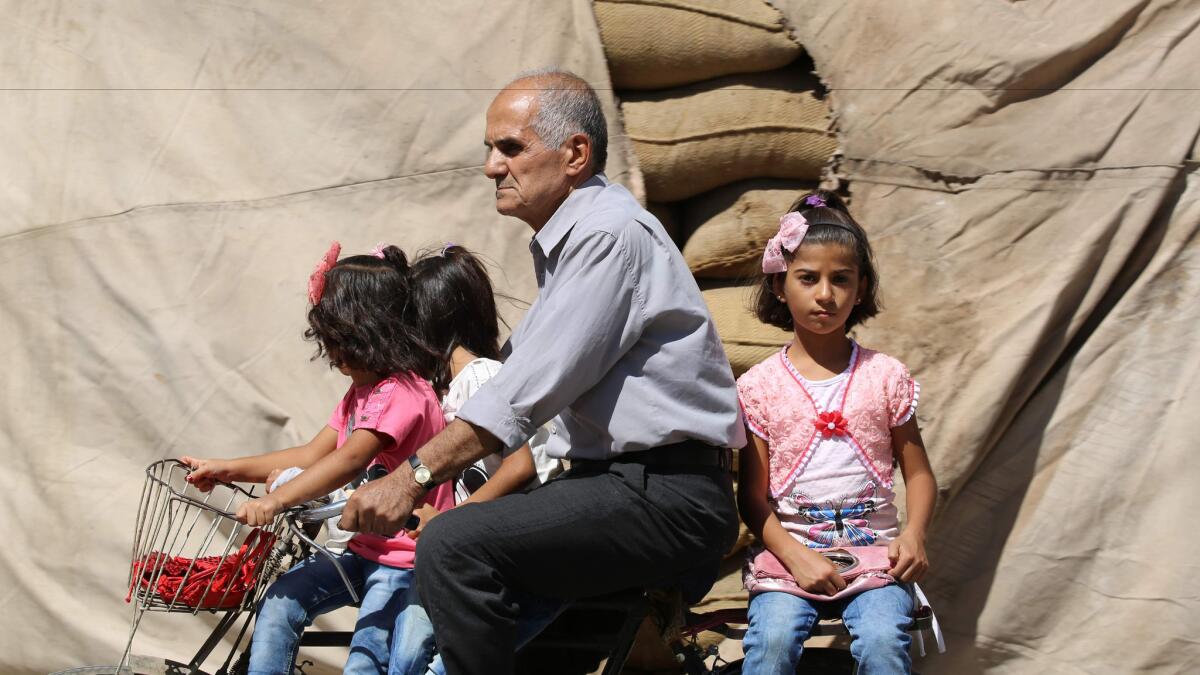Syria cease-fire: Obstacles to providing humanitarian relief to people under siege

- Share via
Reporting from ISTANBUL, Turkey — One day into Syria’s latest cease-fire, the United Nations said Tuesday that violence had decreased significantly in the war-ravaged country, but a system for delivering humanitarian aid remained undetermined.
While “some level of violence” continued after the start of the cease-fire at sunset Monday, reports indicated “a significant, significant drop,” said Staffan de Mistura, the U.N. special envoy.
The first attempt to deliver aid to the rebel-held city of Aleppo, however, failed to reach its destination after the Syrian government demanded prior approval of all aid shipments.
The delivery failure exposed a possible gap in the cease-fire agreement the United States and Russia negotiated in Geneva and announced Saturday: how humanitarian aid would reach the estimated 1 million people who have been living in dire circumstances under government siege for up to four years.
The Syrian government said it would block any humanitarian aid entering Aleppo that was not “coordinated” with the government and the U.N. It said this applied especially to Turkey, which has long supported the Syrian opposition seeking the ouster of President Bashar Assad.
De Mistura said Syria only had to be notified about U.N. aid shipments to Aleppo and had no right to inspect or block it.
It appeared that Turkey’s shipment had not been sanctioned by the U.N. Turkey’s state-run Anadolu news agency claimed that the 20 trucks of flour and food sent to the border were a U.N. convoy, but the U.N. said it hadn’t yet approved any shipment because of the risks of transiting the war zone between the Turkish border and Aleppo.
“We are waiting for this cessation of hostilities to actually deliver the assurances and the peace before trucks can start moving from Turkey,” Jens Laerke, a U.N. spokesman, told Reuters on Tuesday. “As I speak, that has not been the case.”
Russia, an ally of Assad, charged that moderate rebels had broken the cease-fire 23 times, killing six people near Aleppo, while opposition news media reported that Russian or Syrian government warplanes attacked civilian targets.
In Bzaa, a town controlled by Islamic State extremists, three civilians were killed and more than 20 wounded in a Russian airstrike, the Smart news agency reported. Another airstrike, in Al Bab, killed one person, the agency said.
The agreement struck by Secretary of State John F. Kerry and Russian Foreign Minister Sergei Lavrov called for a seven-day cease-fire. If the arrangement holds, it is expected to lead to the setting up of a joint U.S.-Russian military center to coordinate operations against Islamic extremists and eventually a revived effort to reach a political accord between the Syrian government and the opposition.
It’s also supposed to lead to deliveries of food and medical supplies to areas under siege. According to the latest issue of the bulletin Siege Watch, at least 1 million people are living in 40 besieged communities, not including east Aleppo. The quarterly bulletin is issued by two humanitarian watchdog groups, PAX and the Syria Institute.
By virtue of the cease-fire agreement, the Syrian government “needs to allow unhindered access” to U.N. trucks, and a senior U.S. official told reporters in Washington that the Syrian government was expected to pull its forces back.
De Mistura said Russia is obliged to facilitate the movement of the convoys, noting this was still being worked on. The movement of aid from commercial and other sources, De Mistura said, depends on other phases of the agreement.
The full agreement has not yet been made public. After Lavrov said he would like to publish the full texts, the State Department said it favored holding up publication because of the “security details” in them.
Russian state news media reported that the Russian government had set up an observation post on Castello Road, a post intended to enable the Syrian Arab Red Crescent to inspect shipments into the rebel-held zone.
The reception the U.N. will receive when its convoy arrives in the besieged zone remained uncertain. De Mistura indicated he is expecting a hostile reception and said the Aleppo provincial council needs to accept the fact that “this aid is urgent” and there should be “no preconditions.”
In east Aleppo, about 200 marchers staged a demonstration in the Tariq al Bab and Shaar neighborhoods. They protested against the international community’s apparent plan to send food but do nothing to lift the siege.
“The U.N. is a partner in the siege of Aleppo,” read one poster. “Death is better than humiliation,” said another.
A third read: “This is a revolution of freedom, not of hunger.”
Gutman is a special correspondent. Times staff writer Tracy Wilkinson in Washington and special correspondent Duygu Guvenc in Ankara, Turkey, contributed to this report.
UPDATES:
6:30 p.m.: This article was updated with more information about humanitarian aid.
This article was originally published at 2 p.m.
More to Read
Sign up for Essential California
The most important California stories and recommendations in your inbox every morning.
You may occasionally receive promotional content from the Los Angeles Times.









